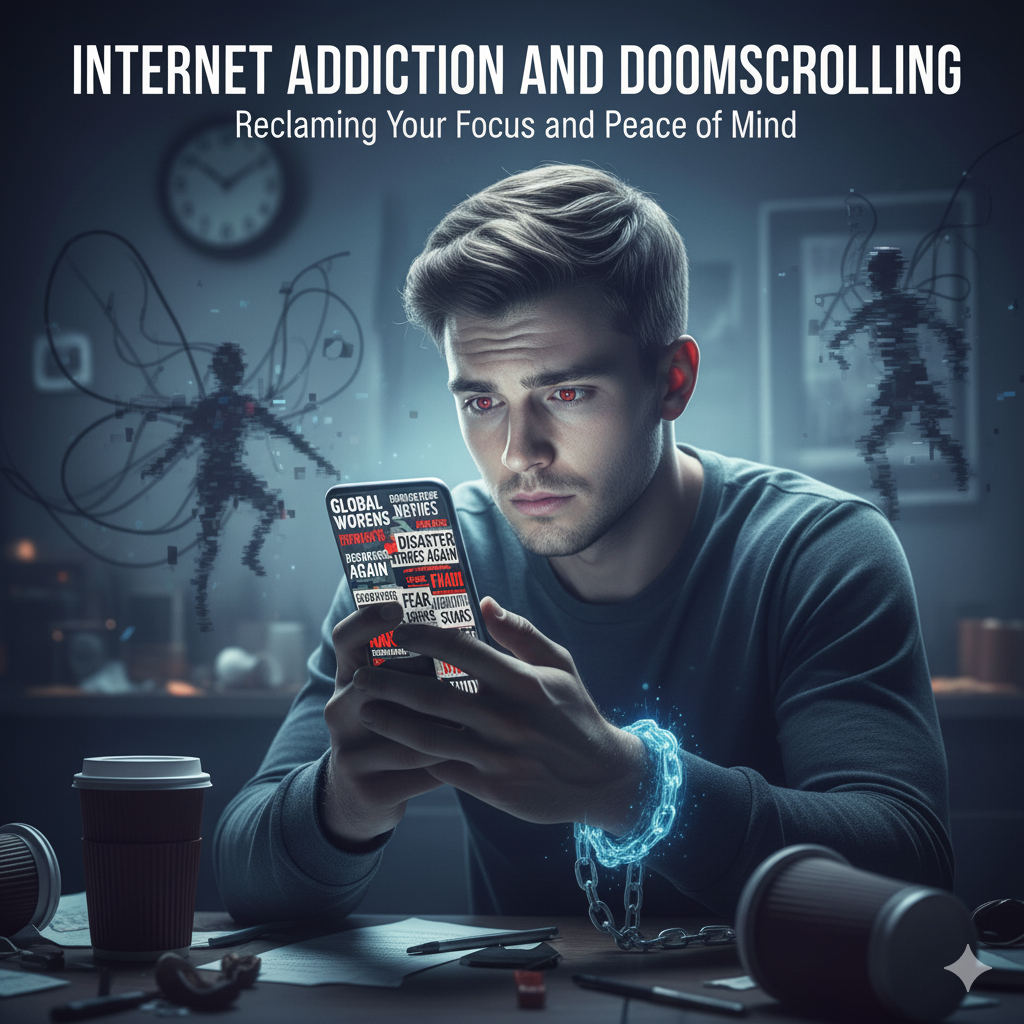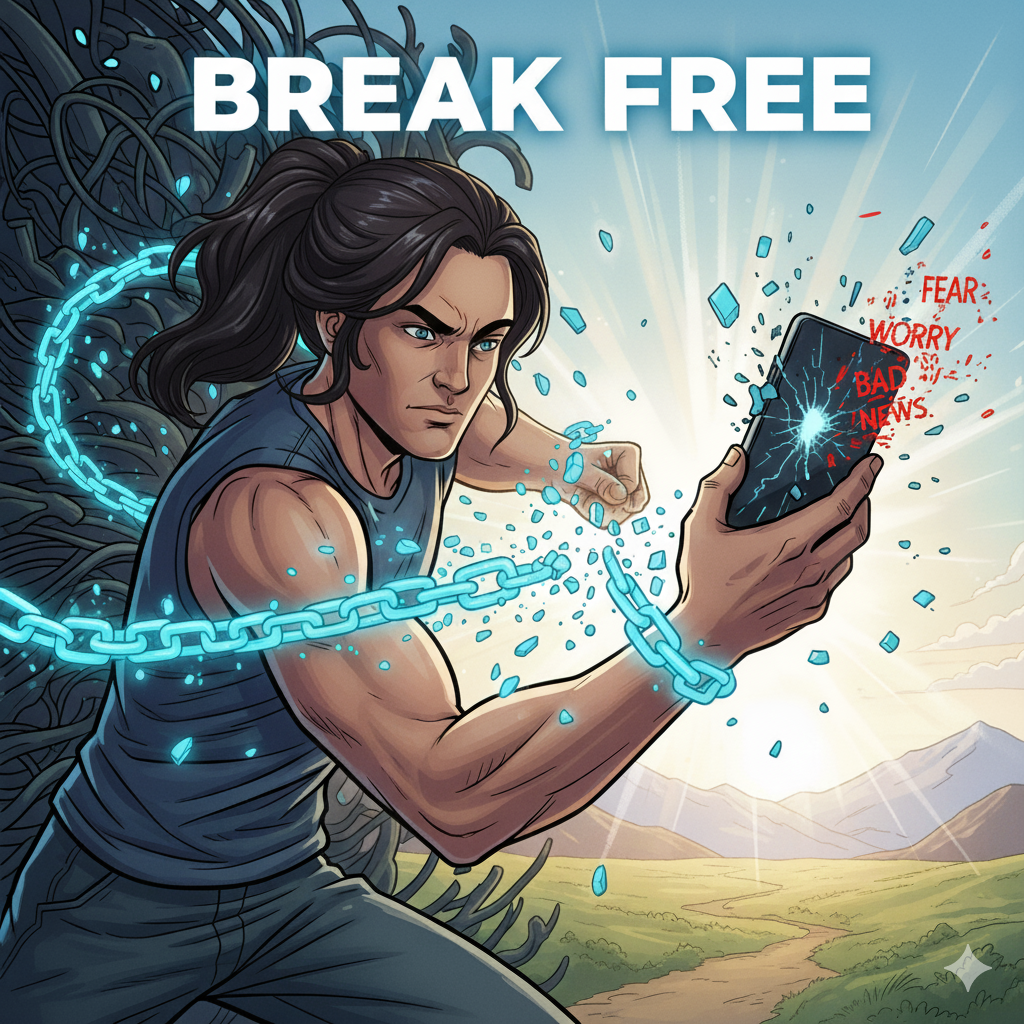Internet Addiction
Internet Addiction and Doomscrolling: Reclaiming Your Focus and Peace of Mind
Internet Addiction
Internet addiction has been described as “excessive or poorly controlled preoccupation, urges, or behaviours regarding computer use and internet access that lead to several computer-based impulse control problems.”
Internet addiction features the core components of addiction (i.e. compulsive destructive habits that interfere with everyday life as well as psychological dependence, mood modification, withdrawal, conflict and relapse). From this perspective, internet addicts often experience cravings and feeling preoccupied with the internet when offline.
What are signs that internet use may be a problem?
- Lying to loved ones about one’s internet use
- Preoccupied with the internet
- Feeling irritable, moody. or depressed when unable to go online
- Difficulty stopping or limiting how much time spent online or do certain things
- Stays online longer than originally intended
What are the conditions that May be Present in People with Internet Addiction?
The signs and symptoms often mimic the signs and symptoms of drug and alcohol addiction. As with other addictions, problems with computer use may be a sign of other major life problems (interpersonal, family, emotional, school, educational), and can often serve as a response to or an escape from the stress of such problems.
Compulsive internet addicts shares many characteristics with other behavioural addicts like pathological gambling or shopping, or addictive disorders such as substance abuse with an inability to control internet usage.

Doomscrolling: Why Professional Help is Essential
You are not alone if you feel trapped in a cycle of constantly checking your phone for bad news. This exhausting habit, known as doomscrolling, is a specialized form of digital compulsion that can severely impact your peace of mind.
If you find yourself unable to stop, feel your anxiety or sadness worsening, or see the scrolling interfere with your sleep, relationships, or work, it’s a clear signal that the habit has moved beyond simply being informed.
Why Willpower Is Not Enough
Seeking professional support is crucial because willpower alone is often insufficient. Doomscrolling is frequently used as an escape or a desperate attempt to manage deep-seated anxiety, uncertainty, or difficult emotions. When you try to stop on your own, those intense, unresolved feelings rush back, making it nearly impossible to maintain the break.
As a psychotherapist, I provide the necessary guidance and a structured path to address the root causes of the anxiety that drives the compulsion, not just the behavior itself. If your problems—no matter how small they seem—are impacting your well-being, they are important enough to discuss. We can work together to stop the cycle and restore balance.
Don’t wait for the scrolling to consume your life. Take the first step toward reclaiming your focus and peace of mind. Contact me today to book a confidential appointment and begin your journey to mindful digital freedom.
What Exactly is Doomscrolling?
Doomscrolling is the compulsive, persistent reading or viewing of negative, distressing, or alarming news and content online. It gained notoriety during the height of the pandemic but reflects a compulsion that existed long before the term was coined.
It’s more than just trying to keep up with the world; it’s a repetitive, often unconscious, action—frequently hitting “refresh” or scrolling endlessly—in a desperate search for clarity or control during uncertain times. The danger is that this behavior is amplified by the very nature of smartphones, which provide unlimited access to news , and by social media algorithms, which are designed to feed you more distressing content if you interact with it.
The Inner Trap: Why It’s So Hard to Resist
This habit feels impossible to break because it hijacks your brain’s natural protective instincts, creating a powerful loop that reinforces itself.
- The Brain’s Alarm System: Humans are naturally wired to pay more attention to bad or threatening news—it’s an ancient survival trait. When you see alarming news, your body releases stress hormones like adrenaline, urging you to keep scanning the environment for threats. Doomscrolling mistakenly satisfies this urge, giving you the illusion that you are protecting yourself by staying “glued to the news”.
- The Vicious Cycle of Anxiety: Ironically, while you scroll to reduce worry, the act consistently increases your overall stress, anxiety, and feelings of sadness and fear. This creates a self-reinforcing pattern: you feel anxious, you scroll for temporary relief, the content makes you feel more stressed, and the need to scroll intensifies.
- Doomscrolling as Escape: For many, the behavior is used to escape immediate personal anxieties, emotional distress, or unresolved daily challenges. This avoidance strategy prevents you from addressing real-life issues and further reinforces the cycle.

The Pervasive Cost
When this compulsion takes hold, it dramatically impacts your well-being, sharing many features of behavioral addiction, including loss of control.
- Worsening Mental Health: High rates of doomscrolling are significantly linked to worsening symptoms of depression and anxiety. The constant negative focus reinforces existing negative thoughts and can even trigger panic attacks.
- Physical Toll: The constant state of “fight or flight” triggered by upsetting news causes stress hormones to spike repeatedly, leading to persistent fatigue and stress-related physical symptoms.
- Loss of Function: The inability to limit usage leads to major functional interference, including chronic sleep disturbances (insomnia), isolating from loved ones, and difficulty focusing at work or school.
If you recognize these patterns, it is time to seek professional support. Working with a counsellor provides the personalized strategies needed to interrupt the compulsion, manage the underlying anxiety, and regain control over your life and attention.